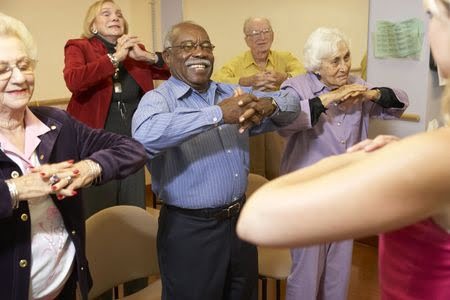- Updated on July 31, 2019
![]() By Dr. Artour Rakhimov, Alternative Health Educator and Author
By Dr. Artour Rakhimov, Alternative Health Educator and Author
 Apart from breathing and physical exercises for elderly (Part 1), elderly Buteyko students are going to benefit with easier breathing and higher CPs from the following specific factors:
Apart from breathing and physical exercises for elderly (Part 1), elderly Buteyko students are going to benefit with easier breathing and higher CPs from the following specific factors:
1. Grounding (Earthing)
Grounding was normal for 99% of human evolution due to the barefoot lifestyle and use of leather (conductive) shoes in more recent times. However, due to the invention of (nonconductive) rubber and surfaces on the floor, it is often a serious technical challenge to ground an average modern person.
There are many commercial products that can be bought online (e.g., on Amazon), such as a grounding mat that can be used during sleep. However, a better option is to use a piece of conductive fabric attached to the sole of the feet, with the other end of the conductive metal wire attached to one of the plumbing tubes or a radiator. More details about grounding methods will be published later.
Grounding has a strong and sometimes very strong effect, especially for people with low and very low CPs (less than 20 and 10 s). But even breathing students with 30+ morning CPs usually experience positive effects of Earthing. Depending on their health state, students may require from 1-2 up to 5-8 hours of grounding per day. These ideas are also applicable to those who are very old (over 80-90).
2. Shaking (vibrations of the human body)
Dr. Buteyko discovered positive effects of mechanical vibrations on the human body about 4 decades before the appearance of vibration machines and devices that have been popular for about 10 years.
The absence of mechanical stimulation for tissues and bones leads to such common concerns among the elderly as diverticulitis and osteoporosis. Children do not have these problems because they jump and get strong body shaking 1,000s times every day. However, with aging, many people stop jogging, playing sports, and start to move slowly. As a result, they do not experience any intensive mechanical stimulation for the bones of organs.
Possible solutions are: resuming jogging for 30+ min per day, daily skip roping (at least 20 min daily), or using a vibration machine for a few minutes 2-3 times per day.
Those who are frail, or with physical impairments that restrict exercise, or over 80, and who cannot afford a vibration machine will benefit from a physical exercise program that gradually introduces, over a period of many months, more intensive types of shaking and body vibrations. It is beyond the scope of this article to provide details of this program here.
3. Perspiration
Another common feature of aging is an absence of activities that produce sweating or perspiration. This is another feature of the traditional Buteyko method. As it was quoted in Part 1, Dr. Buteyko said in his 1972 Lecture in the Moscow State University, “We need about three hours of hard work every day to perspire. This will be a standard for man.”
Is there a difference between different types of perspiration? Yes, night sweats are symptoms of poor health. Sweating in a sauna is healthy, but sweating due to exercise is even better (possibly much better).
Since it is harder to exercise rigorously and sweat with aging, the elderly can use more (heavier) clothing during or at the end of an exercise. This simple method dramatically increases perspiration (up to 10 or more times).
Those breathing students who are prone to overheating and experience headache and other symptoms after overheating can use warm vests or jackets. This allows them to keep their arms and legs (for vests) or legs only (for jackets) uncovered for better heat exchange during exercise.
The primary goal here is to have large wet spots on a t-shirt after exercise, while the criteria of success are the absence of offensive or unpleasant smell from perspiration (ancient yoga books also claim that real yoga masters have sweet sweat).
Depending on the age and other factors, elderly breathing students need to find natural methods (not night sweats) that allow them to have daily sweating.
4. Cold shower
Taking a cold shower is another classical Buteyko technique. Hundreds of recent clinical studies are focused on the generation of brown fat cells in the human body. In fact, it is possible that brown fat cells are one of the most researched topics in modern medicine.
Since contemporary people do not stimulate themselves with cold water, they gradually lose brown fat cells completely. The popular suggested and investigated methods involve the application of medical drugs and other artificial techniques. However, the natural solution to this challenge (how to produce brown fat cells in the body) was provided over 50 years ago by Dr. Buteyko. He advised the daily use of a cold shower (with certain rules explained, for example, here: https://www.normalbreathing.com/cold-shower). Having over 20 s for the current CP is one of these requirements.
The final goal for this technique is to gradually achieve 5 min of ice cold water exposure per day in total. Practice shows that, with self-discipline and perseverance, it is possible.
It is known that, with 20-25 s for the current CP, taking a cold shower is not an activity that Buteyko students crave for or enjoy. However, life is a struggle for these CPs, and a failure to involve these additional methods eventually leads to heavier breathing and health deterioration.
Conclusion
These specific health factors allow the elderly to keep easier breathing with aging even when these students have less than 40 s for their morning CPs. The most natural approach is to have over 50 s morning CP so that fewer efforts are required, and the above-mentioned activities are pleasant and desirable.

